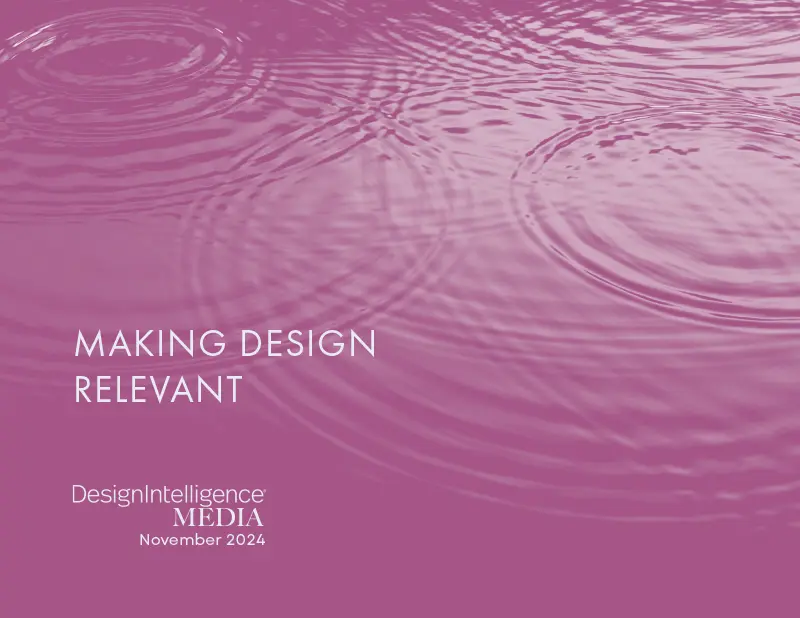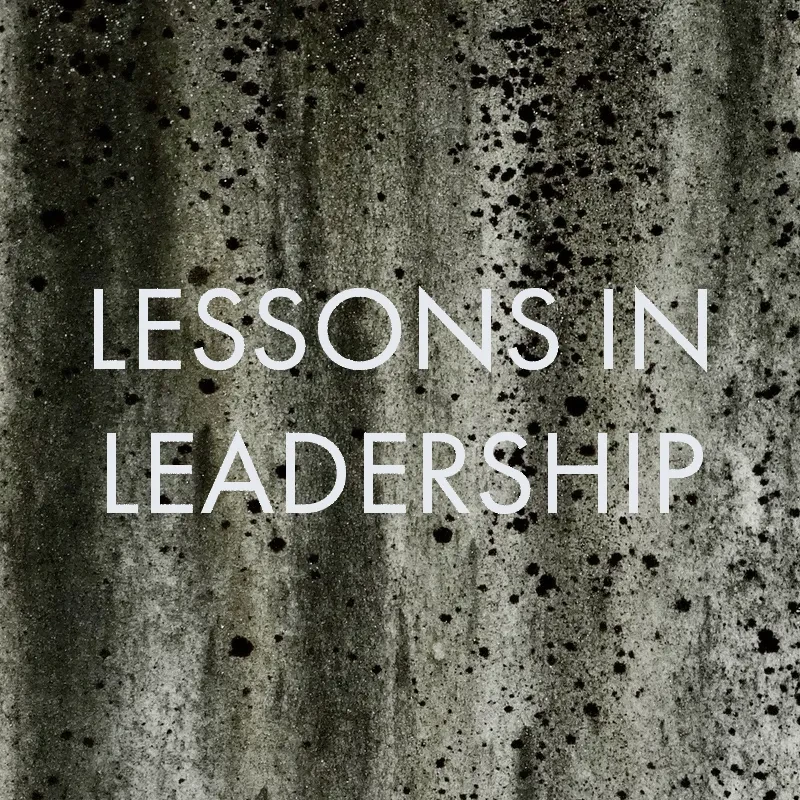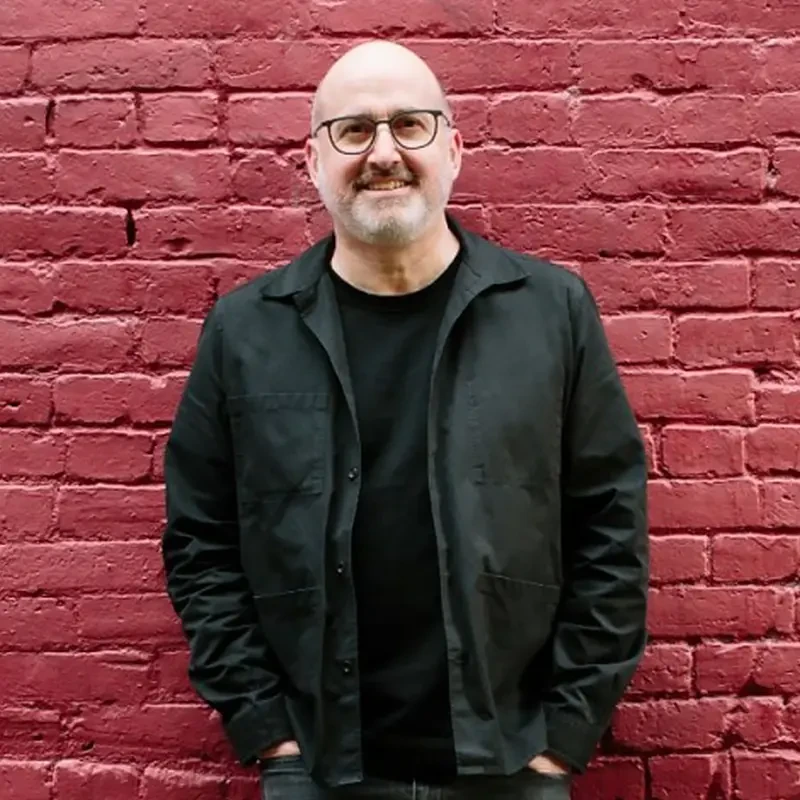
Making Design Relevant
Adrian Parr Zaretsky
Dean, College of Design at the University of Oregon
Senior Fellow, Design Futures Council
November 6, 2024
Adrian Parr Zaretsky considers four global issues and trans-environmental thinking.
DesignIntelligence / Michael LeFevre (DI): We’re talking with Adrian Parr Zaretsky, dean of the College of Design at the University of Oregon. Our fourth quarter theme is consequential questions and the decisions they frame. As the dean of a leading, multidisciplinary school of design, what questions are top of mind for you? To leap right in, what ARE the consequential questions, in your mind, from your lens as a design school dean, perhaps influenced by your other, prior hats, roles, perspectives and collective experience?
Adrian Parr Zaretsky (APZ): For me, the most consequential question is: What makes design relevant? This question serves as a pivot point for me as a design educator, researcher and advocate because it encourages us to consider a whole gamut of timely issues. These are concerns we share in common with other designers, such as how design works in a time of artificial intelligence, as well as topics pertaining to the reflexive modality of design — namely, the way design practices and thinking are necessarily shaped by current events and circumstances, such as climate change, and, in turn, how design thinking and practices shape the world in which we coexist. Ultimately the question of design’s relevancy is a machinic one of how design relevancy works. The short answer to that is by being both reactive and proactive, realistic and aspirational.
DI: Do you agree with our premise that the questions facing designers these days are more consequential than they may have been in the past?
APZ: Absolutely! Because there is so much at stake in a world with a rapidly changing climate, increasing poverty, deepening conflicts and technological innovation. The question of design’s relevancy prompts consideration of four massive issues and a host of attendant questions:
1. ENVIRONMENTAL DEVASTATION
The building and construction sector continues to be one of the major drivers of climate change, with the building sector being responsible for 37% of greenhouse gas emissions.1 Climate change will reshape life on Earth and design can either be part of the problem or enable us to better adapt and become more resilient as we collectively face sea level rise, more frequent and intense storm activity, heat waves, biodiversity decline and species extinction.
A changing climate impacts the health and vitality of the world’s oceans, wetlands, forests and land cover. At the same time, anthropogenic land use patterns are changing the climate, compromising water quality, precluding groundwater recharge and driving species extinction. As the world’s carbon sinks are removed to make way for human settlements and agriculture, other-than-human species habitats are being removed at an alarming rate. Currently, we are facing a crisis in biodiversity, as other-than-human species are going extinct at 1,000 to 10,000 times the baseline rate.2 This is an unsustainable scenario if left unchecked. I see design as having a lot to offer in responding to this situation. How might we design our built environments to better capture and filter rainwater? How might we integrate other-than-human species habitats more extensively into the built environment? These questions can serve as launch pads for design research and investigation. They are also questions that formed the basis of two exhibitions (one titled “Watershed Urbanism,” the other “Transpecies Design”) I curated for the European Cultural Center’s Venice Biennale exhibits in 2020 and 2022. The exhibits featured the incredible talent of faculty and students at the University of Texas at Arlington and the University of Oregon, along with practitioners such as Michael Van Valkenburgh, HKS and Perkins&Will, to name a few.
2. ARMED CONFLICT
There are approximately 110 armed conflicts currently underway globally.3 The most recent statistics I have on these date to 2022. At that time, the United Nations reported that approximately 50 million people in the world were affected by armed conflict.4 Since that study was published many of the conflicts it referred to persist, such as those in Syria, Yemen and Afghanistan, and new conflicts have arisen. In 2022, war broke out in the Democratic Republic of Congo. Also that year, Russia invaded Ukraine, thus far resulting in the death of 180,000 Russian troops and 31,000 Ukrainian soldiers.5 The following year, war broke out in Sudan and has now resulted in 15,000 dead.6 Later that year, the Israel-Hamas/Hezbollah/Houthi war began, which has resulted in approximately 40,000 dead militants and civilians in Gaza, over 1,300 tortured and murdered Israeli civilians and over 700 IDF soldiers killed.7 To sum it up: the Geneva Academy of International Humanitarian Law and Human Rights reports there are currently 35 armed conflicts on the African continent; 45 in the Middle East and North Africa; 21 in Asia; seven in Europe and six in Latin America.8
What does this mean for the built environment? In the case of Ukraine, as of April 2023, approximately 158,000 residential buildings, 3,200 educational structures and 806 health care facilities were damaged or destroyed.9 The reconstruction of former war zones and the design and development of refugee settlements for those displaced by war are both areas of design practice and thinking that unfortunately need greater attention. I have written more extensively about the challenge war zones present the design community in “Birth of a New Earth,” where I likened this situation to a form of urban clearcutting.10
Armed conflict is decimating not only entire neighborhoods and urban areas, but it is also being wielded as a weapon of war. For example, Hamas has built approximately 350 to 450 miles of tunnels reaching up to 100 feet below the ground with some 5,700 individual entry points. Access to the tunnels is restricted to the militants who built them and the hostages they capture, whilst the civilian population is deserted above ground without bomb shelters or air raid sirens to help protect them during airstrikes.11 When you add to this lethal mix militants deliberately using civilian structures (schools, hospitals, mosques) for military operations, including firing rockets in heavily populated civilian areas, the built environment becomes complicit in a cruel and inhumane war strategy of tactical civilian sacrifice.
There is much at stake. Trans-environmental design extends beyond a single generational perspective, aspiring to support the health and well-being of a variety of species and is multi-scalar in approach.
3. INEQUITY
The increasing inequity between and within countries is a challenge that needs more thoughtful collaboration between designers, planners, policymakers and NGOs. In 2021, the World Economic Forum reported approximately 2% of the world’s population, or 150 million people, as homeless.12 In 2023, the National Alliance to End Homelessness reported there were 653,104 people who were unhoused in the United States, nearly 40% of whom were unsheltered.13 In addition to the growing number of unhoused, those living in inadequate housing, such as in informal settlements, is growing. Currently there are approximately 1.1 billion people living in slums, and we are on course to reach 3 billion slum-dwellers by 2050 in the absence of significant investment in affordable and social housing options.14
Once again, design can be part of the solution here, not the problem. Rather than designing spaces and experiences that are hostile to the unhoused, such as anti-homeless spikes and rails on park benches, designers could be exploring how to better convert many of the unused commercial structures post-COVID into residential units. There is some amazing work being done on temporary or emergency shelters for the unhoused, such as flat pack sleeping pods or tiny home co-ops like Emerald Village in Eugene, Oregon. Working with policymakers and planners, designers can advocate to change authorized density levels and demonstrate the importance of permitting more accessory dwelling units.
4. ARTIFICIAL INTELLIGENCE
The introduction of artificial intelligence into the spheres of design thinking, problem-solving, making and manufacture of designed products, experiences and services is transforming design processes and solutions. Some immediate implications include reducing the time and cost of the design process. There is tremendous potential with sensor technology and machine learning to influence and shape design solutions using real-time data inputs. More and more design solutions are incorporating technologies that are amenable to continual iteration and modification through user interaction.
That said, the age of artificial intelligence presents numerous questions and challenges to the design fields. Do the predictive capabilities of AI match that of human specialists? The gap between the two is where liability rests. It will become increasingly more important for designers to be trained in managing that risk. How might designers improve or modify the rules the machine follows when solving a problem? How reliable are the data sets a machine uses? Some data sets are inherently flawed, reflecting the biases and stereotypes of the historical time in which they were collected. For example, inadequate data on women and people of color may not only be biased, but also often discriminatory. How do designers independently develop or augment the data sets machines use? What are the trade-offs of AI generated designs? Namely, empathic imagination and ethical responsibility, both of which drive the choices a designer makes throughout every phase of the design process. These are specifically human qualities that shape design solutions.
Ultimately, a successful design is not only one that is responsive to user needs, preferences and behaviors, it is affective, meaning its very existence presents a responsibility to not only the immediate user but also to the context in which it exists.
OPPORTUNITIES FOR RELEVANCE
There is much at stake. By extension, this level of criticality presents opportunities for design education, research and practices to meaningfully contribute to transforming how we live together in ways that facilitate the mutual flourishing of present generations, of humans and our other-than-human neighbors, as well as future generations. Or, what I have described before as trans-environmental thinking and practices.15 Trans-environmental design extends beyond a single generational perspective, aspiring to support the health and well-being of a variety of species and is multi-scalar in approach.
DI: You have given us much to contemplate. We thank you for this insight.
APZ: Thank you for this wonderful opportunity to reflect on the consequential questions for design relevance. It seems the opening question became an article in its own right.
DI: Well done.
Footnotes:
1 “Building Materials And The Climate: Constructing a New Future,” United Nations Environment Programme, September 12,
2023, https://www.unep.org/resources/report/building-materials-and-climate-constructing-new-future#:~:text=The%20buildings%20and%20construction%20sector,have%20a%20significant%20carbon%20footprint.
2 “What is the sixth mass extinction and what can we do about it?,” World Wildlife Fund, accessed September 4,
2024, https://www.worldwildlife.org/stories/what-is-the-sixth-mass-extinction-and-what-can-we-do-about-it#:~:text=Currently%2C%20the%20species%20extinction%20rate,we%20humans%20were%20not%20around.
3 “Today’s Armed Conflicts,” Geneva Academy of International Humanitarim Law and Human Rights, accessed
September 9, 2024, https://geneva-academy.ch/galleries/today-s-armed-conflicts.
4 “More than 50 million worldwide hit by urban conflict,” UN News: Global Perspective Human Stories,
January 25, 2022, https://news.un.org/en/story/2022/01/1110522.
5 Marc Santora, “Collecting the Dead Russia Left Behind,” New York Times, March 22, 2024, https://www.nytimes.com/2024/03/22/world/europe/russia-ukraine-toll-bodies.html#:~:text=A%20Ukrainian%20soldier%20collecting%20the,under%20men%20in%20winter%20gear.
6 “Rape, murder and hunger: the legacy of Sudan’s year of war,” UN News: Global Perspective Human
Stories, April 12, 2024, https://news.un.org/en/story/2024/04/1148536#:~:text=Sudan%20was%20plunged%20into%20an,of%20atrocities%20on%20all%20sides.
7 Jewish News Syndicate Staff, “IDF death toll since October 7 hits 700,” Jewish News Syndicate, August
25, 2024, https://www.jns.org/idf-death-toll-since-oct-7-hits-700/;
Volker Turk, “40,000 Palestinian lives lost in Gaza,” United Nations, August 15, 2024, https://www.un.org/unispal/document/gaza-40000deaths-turk-ohchr-15aug24/.
8 “Today’s Armed Conflicts,” Geneva Academy.
9 Daniel Hryhorczuk, et al., “The environmental health impacts of Russia’s war on Ukraine,” Journal of
Occupational Medicine and Toxicology
19, no. 1 (2024), https://occup-med.biomedcentral.com/articles/10.1186/s12995-023-00398-y#:~:text=The%20damaged%20infrastructure%20included%20158%2C000,of%20only%20$3%2C500%20%5B6%5D.
10 Adrian Parr, Birth of a New Earth: The Radical Politics of Environmentalism (New York:
Columbia University Press, 2018): 149–68.
11 John Spencer, “Gaza’s Underground: Hamas’s entire politico-military strategy relies on its tunnels,”
Modern War Institute, January 18, 2024, https://mwi.westpoint.edu/gazas-underground-hamass-entire-politico-military-strategy-rests-on-its-tunnels/.
12 “Global Homeless Statistics,” Homeless World Cup, accessed September 7, 2024, https://www.homelessworldcup.org/homelessness-statistics.
13 Daniel Soucy, Makenna Janes, and Andrew Hall, “State of Homelessness: 2024 Edition,” National
Alliance to End Homelessness, accessed September 10, 2024, https://endhomelessness.org/homelessness-in-america/homelessness-statistics/state-of-homelessness/.
14 “Goals,” United Nations Department of Economic and Social Affairs, Statistics Division, accessed
September 9, 2024, https://unstats.un.org/sdgs/report/2023/goal-11/.
15 Adrian Parr, Earthlings: Imaginative Encounters with the Natural World (New York: Columbia
University Press, 2022).
Adrian Parr Zaretsky PhD, is dean, College of Design at the University of Oregon in Eugene (UO), senior fellow, Design Futures Council. An internationally recognized philosopher, cultural thinker and creative practitioner, she is serving as a UNESCO chair on Water and Human Settlements. Prior to joining the UO, she served as the dean of the College of Architecture, Planning and Public Affairs at the University of Texas at Arlington, and as the director of the Taft Research Center at the University of Cincinnati.
Zaretsky has published eight books. “Earthlings: Imaginative Encounters with the Natural World,” published by Columbia University Press, 2023, earned the Silver Nautilus Book Award in the Ecology and Environment category. UNESCO appointed her to the Global Independent Expert Group to author a white paper on the future of higher education advancing. She is regularly invited and interviewed for her views on sustainability, design education and contemporary culture. She is one of the five founding deans for the National Dean’s Equity and Inclusion Initiative, which was formed in the wake of the George Floyd tragedy. The network has grown to encompass 43 deans, and Zaretsky currently serves as the executive chair.
Her creative works have won numerous awards, such as Best Experimental Film by the Brooklyn International Short Awards and Best Women Filmmaker in Short by the Austin International Art Festival for her 2023 film, “A Tale of Three Rocks.” In addition to her numerous awards, Zaretsky has been invited to curate and exhibit internationally, including several European Cultural Center (ECC) Venice Biennales, both in art and architecture. Her recent exhibit at the ECC Architecture Biennale featured work by UO students and faculty and showcased a focus on sustainability, reconciliatory and sustainable design philosophies, including mass timber. In addition to being featured in international publications, the exhibition exposed more than 600,000 Biennale participants to the UO and its prestigious research.


























































